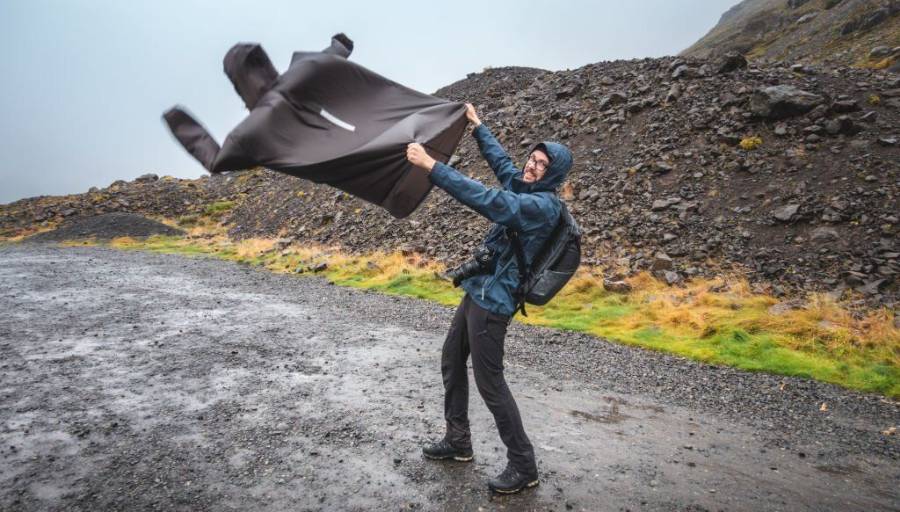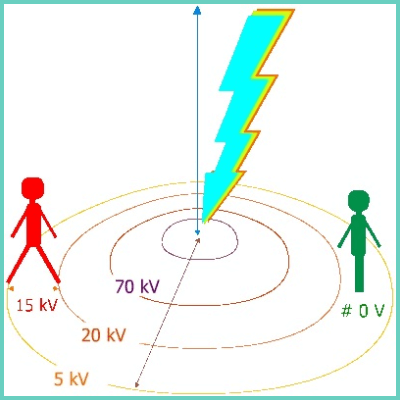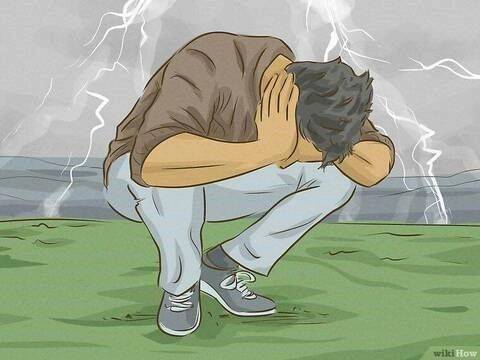Storm When Hiking: How to Stay Safe?
Storms pose one of the greatest risks to hikers, characterized by their unpredictability and potential for violence. Lightning, a formidable force of nature, claims around a hundred lives each year in the United States alone. The inherent danger underscores the importance of taking proactive measures to mitigate risks during a hike, particularly when facing adverse weather conditions like a storm.

As storms can be both sudden and intense, you must prioritize safety by staying informed about weather forecasts and adopting precautionary measures. Awareness of the fundamental nature of storm-related risks significantly improves the safety and enjoyment of outdoor activities. Through careful observation and a basic understanding of meteorology, you can identify the early stages of storm formation.
In this article, we will see various fallback solutions for those caught directly in a storm during a hike. From training and understanding risks to exploring protection systems, let’s navigate the challenges caused by thunderstorms together.
Storm When Hiking: Risky Weather Situation
To enhance comprehension and ensure effective protection, let’s understand thunderstorms, their nature, and associated risks.
What is a Thunderstorm?
A thunderstorm is an intense atmospheric phenomenon with a very limited duration. Most of the time, it lasts about ten minutes but can be spread over several hours when it is stationary and not moving. To form, a thunderstorm needs two things: a mass of warm air near the ground and a mass of cold air at high altitude. Within these air masses, the atmospheric pressure is different, which favors air flows between the two masses. They mix and form a cloud called cumulonimbus, which strongly resembles the chimneys of nuclear power plants!
Inside this cloud, warm air will rise and cold air will sink. These atmospheric currents, which carry the electrical charges that compose them with them, are the lightning creation factors. The storm is born! When the air humidity is high, the water present at high altitudes will tend to come down in the form of drops of water, this is rain.
Explore the Hazards Posed by the Storm
The storm promotes the development of several risks:
- Lightning: as soon as the electrical charge becomes too high in the cumulonimbus, the storm is forced to discharge it in the form of lightning: this is lightning. Unpredictable and too fast to avoid, lightning is fatal in more than 50% of direct lightning strikes. In case of survival, the internal organs are burned to more than 70%!
- Violent wind: as we have seen, hot and cold air currents favor the creation of a vortex within the storm itself. This creates gusts of wind that sometimes exceed 100 km/h in a storm. Also note that tornadoes are stormy winds that manage to touch the ground.
- Rain/hail: the hourly rainfall can be extreme during a storm, which favors the flooding of rivers and mountain torrents.
1st Reflex: Know How to Anticipate the Storm
The first attitude to adopt when the weather is stormy is to anticipate its formation through observation. Like me, you’re not a meteorologist, but a few easy-to-remember tips can help you get there without too much difficulty.
Weather Favorable to the Creation of Thunderstorms
First of all, look at the weather report of the day! Meteorologists indicate when the weather is thunderstorm near your home and from what time. If you see that the day will be stormy and at risk, don’t hesitate to delay your departure by one day.
Also remember that, in summer, thunderstorms tend to form in the late afternoon when the air is warmest and the ground gives off the most heat. The air at the altitude cooled and the storm broke around 6 p.m. This is why leaving early in the morning will prevent you from finding yourself in a thunderstorm at the end of the day.
Recognize a Cumulonimbus
Now you know the favorable weather for the formation of a thunderstorm. It’s time to look at how to recognize them before they even form! For this, remember that several steps are necessary for its formation:
- Humidity turns into cumulus-type clouds
- The cumulus clouds are gathering and the sky is darkening
- The cumulus mingle to form a single cumulonimbus: the storm bursts

Cumulus clouds (also called heat clouds) are the most common clouds. They are recognizable by their cotton shape! The advantage of knowing how to recognize them is that a storm could not form without their presence beforehand.
But be careful, it is not because you will see cumulus clouds that a storm will necessarily form! If the sky is clear when leaving in the morning, many cumulus clouds form in the middle of the afternoon. Then be vigilant, it may be a warning sign of a thunderstorm.
After a few hours, the cumulus present in the sky will come together to form a single gigantic cloud: the cumulonimbus (if the trend is stormy). It is recognizable by its typical mushroom shape, as in the figure 1 above. If you see this type of cloud several tens of kilometers in front of you, you will know that there is a thunderstorm just below!
Try to Predict Its Direction
Knowing how to identify the thunderstorm in the middle of your hike is great, but you need to use this knowledge to protect yourself from it. The first thing to do is not to panic. By keeping your cool, you’ll avoid the most common hiking injuries: strains, sprains and falls.
Did you know falls kill more people every year than storms? So now you are calm and able to spot a thunderstorm, you will have to try to predict its direction. For this, there is no need to check where the wind is coming from. Because in a storm, these are swirling!
To predict its direction, take a few moments to observe it while taking a fixed landmark in the landscape: church steeple, mountain, etc. If after about ten minutes, you realize that it is following a direction other than yours, you can be reassured, you risk nothing since he is moving away! On the other hand, if it comes toward you, you have two options: retrace your steps if you haven’t left for a very long time or find shelter before he joins you.
Storm Above My Head: What to Do?
Sometimes, the lack of visibility or the speed of the formation of the storm does not give us time to see it coming. This is not inevitable. However, there are several ways to protect yourself from the risks induced by the storm.
To Shelter
Taking shelter is a necessity when you are under a storm. Depending on the landscape in which you are hiking, here are several possibilities of shelters likely to protect you against the storm:
- Valley bottoms: it is well known that lightning travels as short as possible and therefore strikes the highest points in altitude. If you are in the mountains, don’t stay at the top and take shelter at the bottom of the valley. In summary, descend as much as possible in altitude!
- Mountain shelters: they are sometimes equipped with a lightning rod! If in doubt, take shelter indoors but do not touch the walls as they can conduct electricity!
- Covered places: in the mountains as elsewhere, churches can be safe shelters against storms because their roof is equipped with lightning rods!
- The caves: it is not by chance that our ancestors found shelters there as early as prehistoric times. The caves protect from the rain but also from landslides. If you manage to find one, stand as far as possible from its entrance and don’t touch the walls.
- The car: a fully enclosed car, excluding convertible models, functions as a Faraday cage. In other words, it provides protection against lightning. If lightning were to strike the vehicle, its body would deflect the electricity to the ground, preventing any impact on the occupants.

Avoid Risky Places
In a storm, because of the sound of thunder and the violent rain that falls on you, you will want to take shelter wherever you think possible. But several places increase the risk in the event of a storm instead of protecting you from it! Here are which ones and why they should be avoided:
- Forests and trees alone: although trees can protect us from the rain thanks to their leaves, it is important not to take shelter under them in the event of a storm. In the case of a single tree, lightning will be attracted to this higher point than the rest of the meadow or clearing. Under it, the risk of electrification is very markedly increased. Forests protect against the risk of lightning strikes, thanks to the uniform vegetation cover. But it’s not just lightning that poses a danger during a storm, there’s also the wind! Falls of branches are very numerous when the storm rages and it is important to avoid staying under the trees from which they fall.
- The clearings/the plain: in a landscape where nothing goes beyond, you become the highest point which will irremediably attract lightning when it strikes the ground. Avoid the clearings!
- Ridges/summits: it’s the same principle as before, except that the mountain peak on which you walk already represents a high point. We have seen it, but you must descend as much as possible in altitude in the event of a storm.
- The rock walls: because of the torrential rains and the lightning that can strike the summits, landslides are frequent during a storm. If you stay close to the walls, you risk being buried.
- Precipices: because of the wind, fear and precipitation, the risk of a fatal fall is multiplied. You must therefore avoid risk areas such as ravines and precipices.
- Electric poles and networks: lightning often strikes electric poles, transformers or high-voltage lines, so get as far away as possible.
- Watercourses: there are several reasons why it is necessary to avoid taking shelter within 200 meters of a watercourse in the event of a storm: flash floods and electrical conductivity. You probably know this, but water is an excellent conductor of electricity. So if lightning strikes near a river, it will carry electricity for several kilometers. Don’t go near it! Finally, mountain streams and meandering rivers can see their level increase tenfold in a few hours due to heavy rainfall. Beware of flash floods.
Lightning Strikes the Ground: The Do’s and Don’ts
You have just seen lightning strike the ground a few hundred meters from your position. While the situation is dangerous and you have not yet found the famous shelter, what should you do? This is an essential question that I will try to answer.
Avoid Running: Step Tension
The first thing to do, as soon as you see lightning strike the ground not far from where you are, stop moving! When lightning strikes the ground, the electrical voltage spreads concentrically around the impact. Even if you are 100 meters from the point of impact, you can be hit by lightning on the ground!
However, if you don’t move, you risk nothing. Why is that? To understand this strange principle, it is necessary to know that the tension that spreads in the ground decreases, on average by 1000 Volts for each meter traversed. In other words, if your feet are close to each other, the tension will be equivalent.
However, electrical voltage works like water pressure: it moves towards the weakest point. So to keep your feet together, you can prevent any electrical movement from one foot to another.
It is when you take a step of approximately one meter that tension of 1000 Volts will cross you while passing by your legs. The higher tension under one foot will join that which is lower, under your second foot… it is electrification. This is why quadrupedal animals have no chance of surviving when they are under the storm: the simple fact of having front and hind limbs so far apart naturally submits them to the tension of stepping.

Safety Position in the Event of a Storm
As soon as the storm is above you and the risk of electrification becomes real, put a minimum distance of 30 meters between each hiker. This will avoid the step tension between two people who are too close. Then, you will have to take a safety position adapted to the situation:
- Place a mat or flat stone on the floor
- Stand on the mat or stone to eliminate direct contact between you and the ground
- Crouch down and put your arms over your head like in an airplane emergency

Final Thoughts
Hiking in a storm can be perilous, but it is not unavoidable for a hiker who is adept at preparing for their day’s walk and is aware of what to anticipate. It is essential to monitor the daily weather each morning and consider delaying the departure if there is an indication of stormy conditions.
It is wiser to forgo a day of hiking than to risk one’s life. Therefore, it is crucial to observe the sky and be attentive to the warning signs of thunderstorms, such as the formation of cumulus clouds during the day or the development of a cumulonimbus. By doing so, you can anticipate the direction of the storm cell and make informed decisions about whether to backtrack, proceed, or seek shelter.
Opting for shelters located at the bottom of the valley or churches equipped with lightning rods is essential. Additionally, consider seeking refuge in caves when in mountainous terrain or using your car if it is nearby. Avoid forests, mountain peaks and areas around rivers that are particularly at risk in the event of a storm.
Finally, be vigilant in the event of a lightning strike on the ground, and make sure to take the safety position to avoid step tension. That’s it, you are now ready to recognize thunderstorms and protect yourself from them when hiking!
Read Also…




